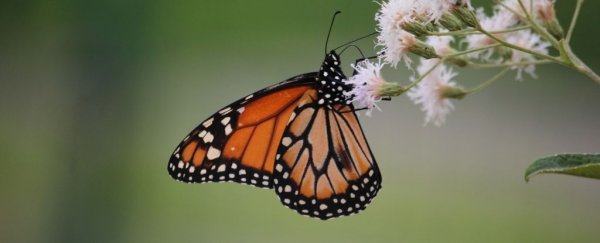The poisonous toxins of milkweed plants seem to have caused an evolutionary cascade through multiple layers in the food web, causing the same genetic mutations in bugs, worms, mice, and birds.
Monarch butterflies were among the first insects found with this special genomic twist, which allows them to feed on the toxic cardiac glycosides produced by milkweeds (Apocynaceae) without dying. Instead, these toxins are sequestered in certain parts of the butterfly's body, providing defense against predators.
The black-headed grosbeak (Pheucticus melanocephalus) is one such predator, known to migrate to Mexico during winter, where it treats itself to beak-fulls of monarch butterflies.
Scientists have long suspected there is something about this bird that allows it to eat such a poisonous insect without dying, and now, it appears this animal has evolved some of the same protective mechanisms as its meal.
When the genome of the black-headed grosbeak was published last year, researchers started looking for the same mutations as that seen in monarch butterflies.
In the end, they were able to find two out of all three genetic quirks found in the butterfly's sodium pump genes within this predator.
These pump genes are responsible for moving sodium in and potassium out of a body's cells, but milkweed toxins can block this pump and cause chaos within the body.
Animals with hearts, like birds and humans, can actually die from heart failure if enough of the toxin is consumed.
Mutations in pump genes may therefore be necessary for survival if your main meal consists of milkweed toxins.
"It solves this mystery from 40 years ago where the biology was pretty well worked out, but we just couldn't go down to the lowest level of organization possible, the genome, to see how grosbeaks are doing this," explains evolutionary biologist Noah Whiteman from the University of California Berkeley.
"It looks like, amazingly, they are evolving resistance using the same kind of machinery in the same places in the genetic code as the monarch and the aphids, the bugs and the beetles, that feed on milkweeds, as well."
Even more astonishing is the fact that researchers were able to locate these genomic mutations in multiple layers of the food chain.
For instance, the parasitic wasp, Trichogramma pretiosum, which feeds on monarch eggs, also has two mutations in the same part of the sodium pump gene as the butterflies.
Meanwhile, deer mice (Peromyscus maniculatus), which feed on monarch butterflies, have all three mutations, as does the nematode, Steinernema carpocapsae, which lives in the soil around milkweed plants.
Together, the results suggest that at least two substitutions in the pump genes are needed to allow animals to prey on monarch butterflies, although further genetic experiments are needed to confirm this hypothesis.
"It's remarkable that convergent evolution occurred at the molecular level in all these animals," says evolutionary systems biologist Simon 'Niels' Groen from the University of California Riverside.
"Plant toxins caused evolutionary changes across at least three levels of the food chain."
The fact that all four of these animals are distantly related suggests this predator-prey battle has deep evolutionary roots. Plant toxins, in other words, may have caused a domino effect of mutations across multiple levels of the food web.
The authors can't be sure if these are the only genetic mutations required to consume milkweed toxins, but they hope to answer this question with further genomic research.
The black-backed oriole (Icterus abeillei), for instance, consumes up to a million monarchs each winter, and yet it tends to pick around the most toxic parts. Grosbeaks, on the other hand, eat the whole butterfly.
The genome of the orioles have yet to be sequenced, but when they are, it will be interesting to note if they hold the same genetic mutations in the pump genes, or if they have adapted a different mechanism.
"My guess is, there are other parasitoids out there, and predators that have also evolved resistance mutations that are interacting with monarchs, and it's just a matter of time before they're discovered," says Groen.
"We know that this isn't the only way to evolve resistance to cardiac glycosides, but it seems to be the predominant way – targeting this particular pump."
The study was published in Current Biology.
